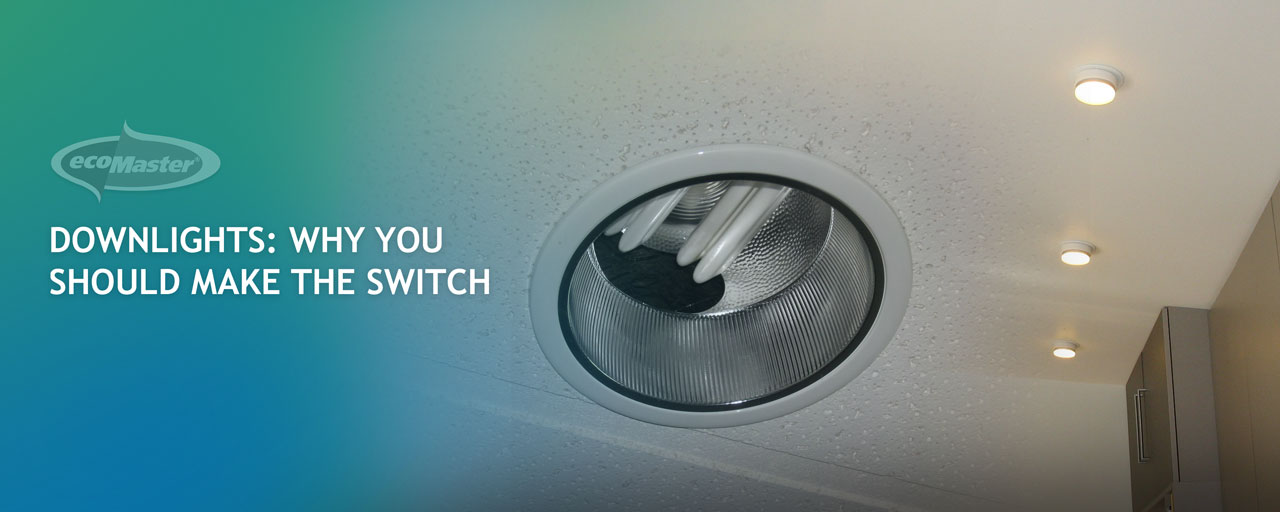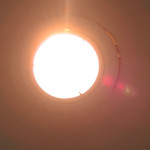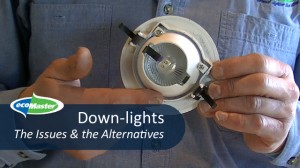
Downlights are not this man’s friend, and after reading this interview, they won’t be yours either.

In this interview, Graeme Ambrose, our guest lighting expert, reveals all of the issues associated with downlights and shares what we can do to make a switch to energy efficient lighting.
As Managing Director and Senior Consultant of the lighting consulting company, Ecodecisions, Graeme is the perfect person to shed some light on the issues associated with downlights.
1. Downlights have been popular for a long time now, what are the draught and insulation issues associated with downlights?
Downlights are one of my pet hates. They are so wrong on many fronts. I will give you a few examples.

a) They get extremely hot, up to 300 degrees Celsius which is hotter than most domestic ovens. I have a portable convection oven in my kitchen. It uses a halogen lamp to do the cooking. Why would you have something that can cook meat in your ceiling?
b) You must have a minimum clearance of 20cm around each downlight which can severely reduce your ceiling insulation and put extra load on your heating systems.
c) Many downlights have gaps around the edges of the fitting or, if they are gimballed (movable) they will be large gaps. This does two things. Firstly these gaps act like little chimneys that lets your central heating leak into your roof space and when the heating is not on it allows cool air from the roof to drop down into the rooms, making the house even colder.
d) Following on from this, when you turn the downlights on they super heat the air underneath them which causes a super up-draught that will literally suck the warm air out of the room. If you are built on stumps and you have polished floorboards this can suck cool air from under the house into the room through small gaps between the floorboards.
e) They are a great way to increase the number of insects in your house.
f) They use a lot of energy to run. Four downlights on 6 hours per day can cost over $157 per year to run. Which is more than an average (under 10 years old) domestic refrigerator uses.
2. Is it possible to fit covers over downlights so that the ceiling can be insulated properly?
It is possible to fit covers over them and bring the insulation closer to the downlight. I don’t recommend it because it is a false economy. They are expensive (between $20-$30 each) and it still means you are paying a fortune to run the downlights.
3. When we have the option to change our halogen downlights to LEDs, is that something you recommend?
Doing a straight changeover of a halogen bulb to LED can cause problems.
a) You still have to have the insulation clearance or a cover.
b) You still have the heat loss problems.
c) You still have insect problems.
d) Depending on the age of your transformers, LED either may not work or you can possibly create electrical “harmonics” that can cause the transformer to fail.
e) Halogen downlights have a 60 degree beam spread. Quite a few LED replacements may have a 25 or 40 degree beam spread which looks ugly.
4. When replacing your downlights, can our existing transformers be utilised?
As I stated previously there can be problems with using the existing transformers. If you are using the old iron core transformers, there is usually no problem.
The newer electronic drivers usually require a minimum of 20 Watts of load to turn on. As most LED replacements are 12 Watts or below, the lights will not turn on.
If your drivers are between 5 and 15 years old you may have the harmonic problem that I talked about before.
I recommend that, when changing to LED, that you either change the transformer as well or rewire to take the GU-10 (240V) fitting which eliminates the transformer all together.
5. What are the issues around downlights that are controlled by dimmer switches?
Good question. People think that if they use dimmer switches with they are using less energy. This used to be the case but with the new electronic dimmers, they still use the same amount of energy. If you have dimmers fitted and you are changing to LED, you must ensure that;
a) The LED is dimmable (a lot aren’t) and
b) The dimmer circuitry is compatible with the LED
6. If you could give householders one piece of lighting advice, what would that be?
If you intend to use LED lights find a supplier that is local, has a good warranty, doesn’t just use eBay to conduct business and has more than just a mobile phone number and a P.O. Box as a point of contact.
Want to learn more about thermal efficiency and lighting?
In this video, Maurice Beinat discusses the issues and the alternatives to downlights.
Click here to visit the video.
Get access to a thermal comfort that lasts today
A whole home energy assessment will show you exactly what needs to be done first to feel warmer sooner. Visit this page to select your ecoHome Assessment. For queries, call ecoMaster on 1300 326 627.


Recent Comments